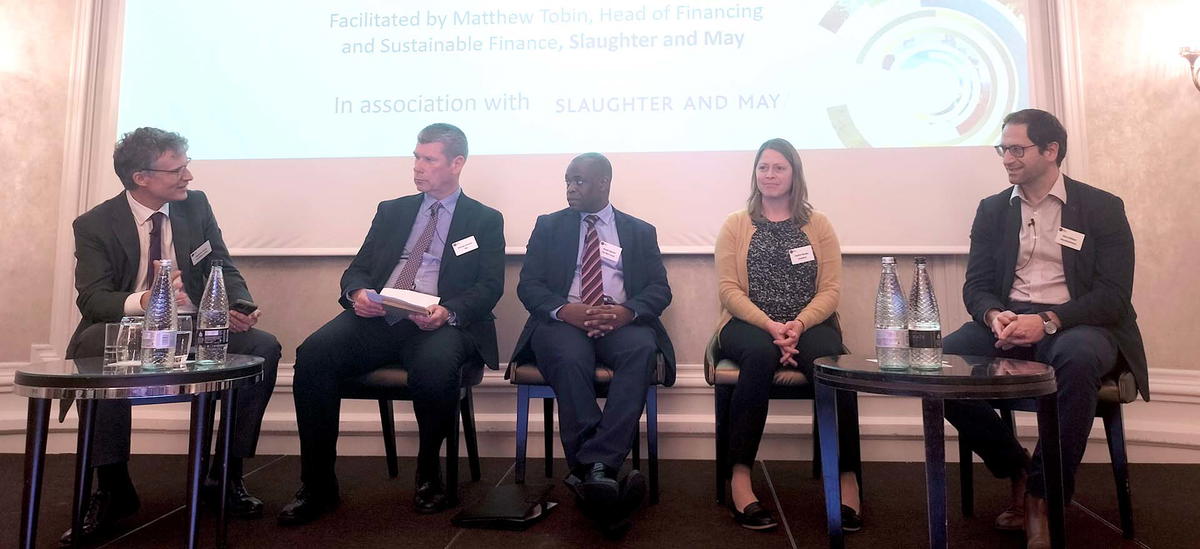

- Neil Ainger
- Freelance Journalist & Treasury Writer
The UK Association of Corporate Treasurers (ACT) held its second annual ESG Conference on 21 November at The Waldorf Hilton London to address what ACT President Joanna Bonnett referred to as “an increasingly important treasury item” at a time when the drive towards green practices and net zero is gathering pace.
Opening speaker, Bernice Lee, Geopolitics and Trade Research Director at the Chatham House think tank, covering Climate Action and Futures, welcomed attendees to the ACT’s second environmental, social and governance (ESG) conference by emphasising finance is moving to the implementation stage: “Where the rubber hits the road. This involves politics, risk, and business overlapping. It’s an engineering and an investment challenge.”

The hundreds of bankers, corporate treasurers from Heathrow, Weir, Kingfisher and others, plus regulators, green activist investors, lawyers and others gathered in London to listen to a one-day conference programme outlining how ESG will impact the buy- and sell-side of investing. Its remit extends to loan and insurance pricing, corporate reporting and 21st century business generally as the transition towards a green economy and social well-being metrics escalates.
Energy company SSE joined the keynote treasury panel to explain how they raised more than $3bn from issuing green bonds on the financial markets. Its first launch happened back in 2017 and has been followed by five more sustainable fundraisers where the company has made its green effort plain to investors.
“Our latest bond is financing the Viking offshore wind farm in Shetland, UK,” explained George Duncan, Head of Group Funding, SSE during a panel session dedicated to the role of the treasurer in ESG. “Investors like it when you show them where the money is going.”
The corporate also has KPIs to make its ambitious targets to cut CO2 emissions clear, and to try to avoid any accusations of ‘greenwashing’ by setting firm targets for itself. The SSE KPIs include:
- Encouraging a set number of heat pumps in homes and businesses
- Reducing CO2 at the firm by 80% by 2030 as a waymark along the way towards the global ambition of net-zero emissions by 2050
Fellow ACT ESG panellist Alouis Ngoshi, Group Treasurer at The Weir Group, told his peers and the hundreds of other senior attendees about his company’s experience.
The focus for Weir in recent years has been on the disposal of its oil and gas interests to focus purely on mining, particularly of precious metals such as nickel. These will power electric vehicles (EVs), batteries, and contribute to the green transition towards a net-zero carbon economy, on which governments are focused. But, as outlined below, the company needed to raise money to refocus its business in this way.
Weir’s sustainability-linked bond
“Our first sustainability-linked bond [SLB] was unveiled in 2021 to raise money for our new mining-only direction,” said Ngoshi, while outlining how the KPI was set against Scope 2 indirect greenhouse gas (GHG) emissions metrics. These emissions are internally caused by activities such as using electricity on company premises. Scope 3 metrics cover indirect emissions emanating from value chain partners, while Scope 1 covers direct emissions from a company itself, such as from the exhausts of company-owned petrol-powered vehicles.
Ngoshi, explained the company’s “green journey continues” with a new SLB due this year, with four new KPIs set against it, including:
- A 30% cut in CO2 by 2030
- A commitment to zero harm from its mining activities, pertaining to the ‘S’ aspect of the ESG agenda. Social wellbeing and governance elements in a firm’s ESG score can help achieve a good outcome even if its environmental damage or emissions are detrimental. The zero-harm approach from Weir will, therefore, improve its ‘E’ score in the aggregated metric in future
Treasurers share experiences and KPIs
Sophie Stoops, Treasury Project Manager at home improvement retailer Kingfisher is just setting out on her company’s journey towards raising green funds, with a sustainability-linked revolving credit facility (RCF) as a baseline for later moves towards SLBs and other forms of green finance. However, the “present instability,” she said – citing geopolitics, with conflicts abroad and a general election due soon in the UK, plus rising inflation and interest rates (IR) – is “making the investment environment challenging”.
Fellow panellist Christopher Dibben, VP of Corporate Finance at British multinational pharmaceutical and biotechnology company GSK, admitted: “GSK hasn’t yet undertaken any green bonds or SLBs,” adding that its position further up the supply chain should make this easier.

But as Dibben pointed out, GSK can easily obtain traditional funds and it already meets many of the ‘S’ social elements of a typical ESG rating and it has good governance. The firm isn’t a big polluter and makes medication, contributing towards the greater social good. Moreover, GSK has many outreach projects and social KPIs around the world.
On the topic of KPIs and wider sustainability metrics, FIs want a standardised ESG approach, of course, but Dibben maintained that “there hadn’t been any pushback from banks” yet about past traditional fundraising initiatives GSK has undertaken. The company already has these types of metrics available in the corporate social responsibility (CSR) aspect of its annual report, so it can access the desired information.
Dibben added: “Corporates will have to report ESG metrics soon anyway, even if they don’t have an ESG product, so we are preparing for this [data presentation] challenge.”
Data metrics
As Dibben alluded to, the UK and other governments and regulators globally are keen to support the nascent green economy, so they are increasingly demanding standardised ESG metrics and data – as indeed are banks and investors. Corporates need to meet this data accumulation and presentation challenge, sometimes with the help of third-party providers.
Several panellists outlined that an FI could conceivably be sued in future if it didn’t carry out its ESG due diligence when lending to an energy company, which could face a more direct threat. The future impact on pricing for companies without a good ESG narrative and metrics vis-à-vis insurance, loan costs, and so on, should be clear.
The need for and drive towards a standardised approach in order to assess pricing and measurement in this evolving field is evident as well, not last via the EU green bond standard (EUGBS). Available to all green bond issuers (in and outside of the EU) this code is designed to help the financing of sustainable investments in future. It emerged out of a desire to harmonise the European sustainable bond market and improve transparency and market integrity.
ESG standards
The UN’s 17 Sustainable Development Goals (SDGs), including social wellbeing metrics, are a key driver in the data field of this emerging area. The ESG ratings often map to the SDGs. Sustainable Fitch gave a presentation at the ACT conference to explain the various approaches and ESG ratings methodologies that are developing, and how they might eventually standardise.
Meanwhile, Paul Dickinson, Founder and Chair of the Carbon Disclosure Project (CDP), talked separately at the conference about how ESG is an approach and “not a dull regulatory thing.”

The CDP, which is a not-for-profit charity, is the original rater of climate risk emissions. It feeds data to Morgan Stanley Capital International (MSCI), Moody’s and other ESG data providers. Dickinson added, as evidence that ESG isn’t dull, that: “You might also be able to claim tax back” under stimulus packages such as the US’ multibillion-dollar Inflation Reduction Act (IRA) of 2022.
Despite its name, the legislation is less about taming inflation but is rather a package of green industrial subsidies and tax cuts designed to encourage the green transition, retain jobs, and protect supply chains.
In regard to what standardised approach will win out in future in regard to SLB fundraisers, Dickinson, said: “My bet is on the work being undertaken by the International Sustainability Standards Board [ISSB] emerging as the global standard.” This is being created based on the various national standards that some countries already have, or are developing, as is the case in the UK.
ISSB: sustainability disclosures
Formed on 3 November 2021 at COP26 in Glasgow, UK, the ISSB is a subsidiary of the International Financial Reporting Standards (IFRS) Foundation dedicated to the public interest. It is developing international standards that will result in a high-quality, comprehensive global baseline for sustainability disclosures, which are focused on meeting the needs of investors and the world’s financial markets.
The ISSB’s work builds on prior reporting initiatives, such as the Climate Disclosure Standards Board (CDSB), the Task Force for Climate-related Financial Disclosures (TCFD), the Value Reporting Foundation’s Integrated Reporting Framework, and the industry-based Sustainability Accounting Standards Board (SASB) standards, as well as the World Economic Forum’s (WEF) Stakeholder Capitalism Metrics.
The ISSB is backed by the G7, G20, the International Organization of Securities Commissions (IOSCO), the Financial Stability Board (FSB) that first put it forward, plus the finance ministers and central bank governors from more than 40 jurisdictions worldwide. The ISSB’s four key objectives are:
- To develop standards for a global baseline of sustainability disclosures
- Meet the information needs of investors
- Enable companies to provide comprehensive sustainability information to global capital markets
- Facilitate interoperability with disclosures that are jurisdiction-specific and/or aimed at broader stakeholder groups
FCA regulator outlines obligations and opportunities
“ESG is a strategic priority for the Financial Conduct Authority [FCA],” said Jon Relleen, Infrastructure and Exchanges Director at the regulator, during a morning panel session that was dedicated to conduct risk and the fear of greenwashing.
The panel also featured Peter Wickham, a partner at law firm Slaughter and May, providing the litigation risk perspective; Caroline Haas, Head of Climate and ESG Capital Markets, NatWest, giving the investor perspective; and Christopher Rich, General Counsel for the Financial Markets Standards Board (FMSB), who provided the wholesale markets viewpoint.
“The two key words I want to stress are transparency and trust,” said the FCA’s Relleen, as he emphasised these must be the guiding principles for treasurers trying to navigate a fluid, emerging area. He acknowledged initial difficulties but stressed the benefits of fully understanding ESG issues would mean corporates would consequently be equipped to tap into green finance and meet their reporting obligations. Good data and internal processes that adhere to global standards and set ambitious KPIs will be the key to success.
Relleen also discussed the UK’s alignment with the ISSB and moves to clamp down on greenwashing via the UK CP22/20: Sustainability Disclosure Requirements (SDR), which again must be viewed from the international alignment perspective. The CDP charity can assist treasurers seeking information on this topic.
Analysing risk
Elsewhere, nature and biodiversity risk, which is causing scarcity in supply chains and issues with food production, is a new element within the emerging ESG field. It was highlighted as a standalone risk by the FCA’s Relleen when he referenced the Taskforce on Nature-related Financial Disclosures (TNFD) initiative in this area.
A separate panel with three NatWest speakers examined this standalone risk mitigation and opportunity area in more depth during a later panel session. Conduct, nature, climate and other risks all coalesce in the overarching ESG field.
Corporate treasuries need to consider how best to mitigate these risks, while still seeking to maximise advantageous funding. Relleen’s agenda covered:
- Corporate disclosures: such as the voluntary CPD, the domestic UK SDR, and the emerging global ISSB
- ESG products: these include SLBs, green bonds, and how instruments in the asset management area work
- Plumbing for the financial markets: such as ESG benchmarking metrics, ratings, data providers and mapping out how they overlap and can be accessed
Green finance: Heathrow
At the coalface of change – a phrase that will increasingly become obsolete as the green transition advances – is Sally Ding, Director of Treasury and Corporate Finance, London Heathrow Airport.
Addressing the conference in a session seeking to provide a view of the future, she explained how Heathrow has been following its sustainability agenda for 13 years. The company has developed a Strategy 2.0 document to make it easier to continue to obtain green finance by setting clear ‘hard’ KPIs.
The aim is to make Heathrow 100% carbon neutral and help the airlines that use its facility to drastically cut back emissions via the Scope 3 metric. This will build on the work the company has already done to build strong sustainability metrics and tap into finance opportunities within the ‘S’ and ‘G’ elements of ESG. The next step on its journey is to further strengthen its ‘E’ credentials.
“We’ve spent two years developing a carbon reduction target for our business, a first in the sector, that adheres to the Science Based Targets initiative (SBTi),” said Ding. “We’re doing our bit and playing an influencing role with airlines as well, offering them discounts in landing charges, for example, if they use sustainable aviation fuel.”

Greenwashing and investment options
Addressing the fear of failure and accusations of greenwashing by outsiders, Ding maintained that “markets should allow corporates to set ambitious targets and not penalise them for it” with adverse pricing. Both the public and the media also need to be made aware that the green transition has to be financed.
Fellow panellist Claire Dorrian, Head of Sustainable Finance, London Stock Exchange Group (LSEG), talked about how funds can now be listed on markets that release carbon credits and certificates, and the wide variety of global fixed-income products that are now available, such as:
- Green bonds
- SLBs
- Green Sukuk (Islamic) options.
“There are 470 bonds on LSEG markets now that have raised £260bn,” concluded Dorrian, as she emphasised the size and potential of the green market.
The fact that businesses need to raise money to develop the future low- and no-carbon economy was also highlighted. This funding need impacts data and accredited disclosure regimes, banks, regulation, training for treasurers, and all other aspects of the future business environment. The journey towards a green future is accelerating and treasurers must get on board.



